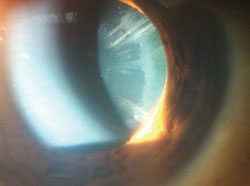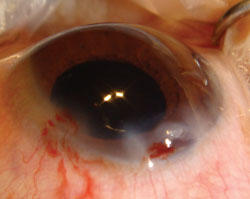Cataract quiz for residents, part 2
Test your knowledge and judgment as you assess risks and predict outcomes in six clinical scenarios.
 Uday Devgan |
Continuing from the previous column, this is the second part of the cataract surgery quiz for residents. Each question presents a challenging clinical situation. Use your best judgment to select the most appropriate answer.
1. At the preoperative examination for this patient, you notice flakey material on the anterior lens capsule of the cataract. The patient has an otherwise normal slit lamp examination. When performing biometry you note that the anterior chamber seems somewhat shallow at 2.01 mm, particularly in this myopic eye that has an axial length of 25.30 mm. What best describes the intraoperative findings that you may encounter during cataract surgery?
 Question 1 image. Images: Devgan U |
a.The patient may have loose zonules, which can make the capsulorrhexis more challenging and lead to complications such as IOL dislocation and capsular phimosis.
b.The patient is prone to iris prolapse due to floppy iris syndrome and may experience iatrogenic damage to iris stroma.
c.The patient may experience prolonged corneal edema due to a weak corneal endothelium, which is associated with this condition.
d.The patient may have a weakness or break in the peripheral retina, which increases the risk of a retinal detachment.
2. Which statement best describes the characteristics of a venturi vs. peristaltic pump on the phaco machine?
a.The peristaltic pump can create vacuum levels on demand without occlusion of the phaco tip.
b.The venturi pump uses pinch rollers to milk the fluid along the tubing so that it can drain into the plastic waste bag.
c.The peristaltic pump requires occlusion of the phaco tip in order to generate vacuum levels to the requested level.
d.The venturi pump is not as safe as the peristaltic pump because it tends to build vacuum too quickly, which causes surge.
3. This patient has a working glaucoma drainage tube appropriately placed in the superonasal quadrant of the anterior chamber of the left eye. The patient needs cataract surgery, and you are preparing for the case. What best describes the most important challenge that you will face during surgery?
 Question 3 image. |
a.The drainage tube may block your temporal clear corneal phaco incision, necessitating a switch to a different position for surgery.
b.The density of the cataract will require extra phaco power and energy, which could cause ultrasonic damage to the drainage tube.
c.The drainage tube may block the insertion of the IOL, and the patient may end up aphakic with a contact lens.
d.The drainage tube can increase the fluid outflow from the eye, causing increased chamber instability during cataract surgery.
4. When making a temporal corneal incision for phaco, what characteristics are ideal for ensuring less astigmatic effect and tighter sealing?
a.A shorter tunnel length, a peripheral incision that nicks limbal vessels and a large width.
b.A shorter tunnel length, a somewhat central incision closer to the corneal center and a narrow width.
c.A longer tunnel length, a peripheral incision that nicks limbal vessels and a narrow width.
d.A longer tunnel length, a somewhat central incision close to the corneal center and a large width.
5. At the end of nucleus removal using phacoemulsification, you note that the corneal incision looks white and distorted with a fish-mouth appearance. What is the likely cause of this situation?
 Question 5 image. |
a.Too much balanced salt solution was used for irrigation due to a high flow rate, so the cornea has become hydrated.
b.Too much phaco power, not enough fluidic cooling and phaco needle compressed against the incision has caused a phaco wound burn.
c.Too much use of phaco power modulations with too low of a duty cycle was used, and that has ultrasonically damaged the cornea.
d.Too much anesthetic was given, which has damaged the corneal stroma due to the acidic nature and low pH of the medication.
6. Which of the following are potential complications of routine, uneventful phacoemulsification cataract surgery with implantation of an IOL?
a.Posterior capsule opacification can occur, blocking the visual axis and blurring the vision.
b.Endophthalmitis can be caused by the patient’s own ocular flora and can result in loss of vision.
c.Corneal endothelial cell loss can occur due to the ultrasonic energy as well as the fluidic currents in the eye during surgery.
d.Emmetropia may not be achieved due to corneal astigmatism or variability in effective lens position causing a myopic or hyperopic shift.
e.All of the above.
Answers
1. a. The patient has pseudoexfoliation, which can cause loose or weak zonules. With a shallow anterior chamber in the setting of a longer axial length, there is a strong likelihood that the entire lens-iris diaphragm has been pushed forward, indicating weakness of the zonules. Pseudoexfoliation is not typically associated with a weak corneal endothelium, retinal breaks or floppy iris syndrome.
2. c. A peristaltic pump uses pinch rollers to milk fluid along the tubing and requires occlusion of the phaco tip in order to achieve the surgeon’s desired vacuum level. A venturi pump can deliver high vacuum levels instantly and requires a rigid drainage cassette in which to create the vacuum.
3. d. The glaucoma drainage tube is an outflow site and can cause imbalances in the phaco fluidics. To minimize surge, we need to keep the inflow of fluid balanced with the outflow. There is just one source of inflow fluid, the infusion bottle of balanced salt solution. There are typically two sources of fluid outflow: what is aspirated from the phaco tip and what leaks from the incisions. With the glaucoma drainage tube in the eye, there is now a third source of fluid outflow, which could cause the fluidic imbalance.
4. c. The corneal incisions, which are more peripheral to the point of nicking the limbal vessels, tend to have less astigmatic effect and better long-term sealing. Longer tunnel lengths provide more surface area for apposition of the incision and tend to seal better and have less astigmatic effect. Narrower incisions also seal better and have less astigmatic effect, which is why phaco has moved from 3.5-mm incisions toward wounds that are approximately 2 mm or smaller.
5. b. This is a phaco wound burn caused by multiple factors at once: too much phaco power, lack of appropriate phaco power modulations, not enough cooling of the phaco needle by fluidics, and compression of the phaco needle and sleeve against the corneal incision.
6. e. All of these are potential complications of phacoemulsification surgery. Posterior capsule opacification, endophthalmitis, corneal endothelial cell loss and residual refractive error are potential complications even in the most experienced hands.

- Uday Devgan, MD, FACS, FRCS(Glasg), is in private practice at Devgan Eye Surgery in Los Angeles, Beverly Hills and Newport Beach, Calif. He is also chief of ophthalmology at Olive View UCLA Medical Center and associate clinical professor at the UCLA School of Medicine. He can be reached at 11600 Wilshire Blvd., Suite 200, Los Angeles, CA 90025; 800-337-1969; fax: 310-388-3028; email: devgan@gmail.com; website: www.devganeye.com.
- Disclosure: No products or companies are mentioned that would require financial disclosure.








